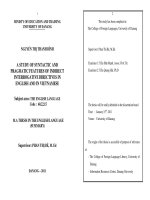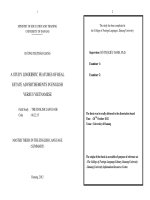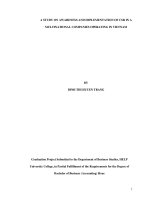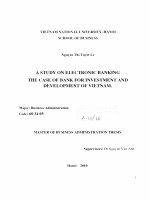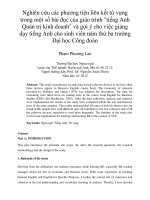A study on lexical and syntactic features of cosmetic product advertisements in english and their vietnamese equivalents
Bạn đang xem bản rút gọn của tài liệu. Xem và tải ngay bản đầy đủ của tài liệu tại đây (4.55 MB, 98 trang )
MINISTRY OF EDUCATION AND TRAINING
HANOI OPEN UNVERSITY
LÊ THỊ TÂM
A STUDY ON LEXICAL AND SYNTACTIC FEATURES OF
COSMETIC PRODUCT ADVERTISEMENTS IN ENGLISH
AND THEIR VIETNAMESE EQUIVALENTS
(NGHIÊN CỨU ĐẶC ĐIỂM TỪ VỰNG VÀ CÚ PHÁP CỦA
QUẢNG CÁO MỸ PHẨM TRONG TIẾNG ANH VÀ CÁC
TƯƠNG ĐƯƠNG TIẾNG VIỆT)
M.A. THESIS
Field: English Language
Code: 60220201
Hanoi, 2015
MINISTRY OF EDUCATION AND TRAINING
HANOI OPEN UNVERSITY
LÊ THỊ TÂM
A STUDY ON LEXICAL AND SYNTACTIC FEATURES OF
COSMETIC PRODUCT ADVERTISEMENTS IN ENGLISH
AND THEIR VIETNAMESE EQUIVALENTS
(NGHIÊN CỨU ĐẶC ĐIỂM TỪ VỰNG VÀ CÚ PHÁP CỦA
QUẢNG CÁO MỸ PHẨM TRONG TIẾNG ANH VÀ CÁC
TƯƠNG ĐƯƠNG TIẾNG VIỆT)
M.A. THESIS
Field: English Language
Code: 60220201
Supervisor: Nguyễn Thị Vân Đông, Ph.D
Hanoi, 2015
CERTIFICATE OF ORIGINALITY
I, the undersigned, hereby certify my authority of the study project report
entitled a study on lexical and syntactic features of cosmetic product
advertisements in English and their Vietnamese equivalents submitted in
partial fulfillment of the requirements for the degree of Master in English
Language. Except where the reference is indicated, no other person’s work
has been used without due acknowledgement in the text of the thesis.
Hanoi, 2015
Le Thi Tam
Approved by
SUPERVISOR
(Signature and full name)
Date: ……………………
i
ACKNOWLEDGEMENTS
This thesis could not have been completed without the help and
support from a number of people.
First and foremost, I would like to express my sincere gratitude to
Ms. Nguyễn Thị Vân Đông, my supervisor, who has patiently and
constantly supported me through the stages of the study, and whose
stimulating ideas, expertise, and suggestions have inspired me greatly
through my growth as an academic researcher.
A special word of thanks goes to my friends and many others, without
whose support and encouragement it would have been impossible for me to
have this thesis accomplished.
Last but not least, I am greatly indebted to my family for the sacrifice
they have devoted to the fulfillment of this academic work.
ii
ABSTRACT
This study aims at conducting a study of advertisements for cosmetic
products in English and their Vietnamese equivalents. The data for analysis
in this thesis are 130 samples of advertisements for cosmetic products (100
in English and 30 in Vietnamese) collected from many different sources
such as magazines, television, catalogs and websites of companies
manufacturing cosmetic products in the United States, United Kingdom and
in Vietnam. The study is carried out based on the theories of lexis, syntax
and a combination of a variety of methods such as descriptive, comparative,
contrastive, analytic and inductive. The study focuses on analyzing some
typical linguistic features in order to point out the equivalents between
advertisements for cosmetic products in English and Vietnamese in terms of
their lexical features and syntactic features. The findings of this study are
clearly presented based on a survey of 100 English advertisements for
cosmetic products and 30 Vietnamese advertisements for cosmetic products.
Hopefully, the results of the study will really provide some practical
applications for using English. This study may also be useful for those who
are interested in advertisement, especially advertisements for cosmetic
products.
iii
LIST OF ABBREVIATIONS
CpAE:
Cosmetic product advertisements in English
CpAV:
Cosmetic product advertisements in Vietnamese
iv
LIST OF TABLES
Table 4.1. Verbs in English and Vietnamese advertisements for
44
cosmetic products
Table 4.2. Personal Pronouns in English and Vietnamese
50
advertisements for cosmetic products
Table 4.3. Adjectives in English and Vietnamese advertisements for
56
cosmetic products
Table 4.4. Ellipsis in English and Vietnamese advertisements for
67
cosmetic products
Table 4.5. Imperative Sentences in English and Vietnamese
72
advertisements for cosmetic products
v
LIST OF FIGURES
Figure 1: The distribution of lexical features in CpAE and CpAV
57
Figure 2: The distribution of syntactic features in CpAE and CpAV
73
vi
TABLE OF CONTENTS
Certificate of originality
Acknowledgements
Abstract
List of abbreviations
List of tables
List of figures
Chapter 1: INTRODUCTION
1.1. Rationale for the study
1.2. Aims of the study
1.3. Objectives of the study
1.4. Scope of the study
1.5. Significance of the study
1.6. Structural organization of the thesis
Chapter 2: LITERATURE REVIEW
2.1. Review of previous studies
2.2. Review of theoretical background
2.2.1. Theoretical framework
2.2.1.1. Lexis/ Lexicon
2.2.1.2. Syntax
2.2.1.3. General View of Advertising
2.2.2. Theoretical background
2.2.2.1. Definition of Cosmetic advertisement
2.2.2.2. Feature of Cosmetic advertisement
2.2.2.3. The Persuasion Techniques of Beauty Product Advertisement
2.3. Summary
Chapter 3: METHODOLOGY
3.1. Research-governing orientations
3.1.1. Research questions
3.1.2. Research approaches
3.1.3. Description of samples
3.2. Research methods
3.2.1. Major methods vs. supporting methods
3.2.2. Data collection techniques
3.2.3. Data analysis techniques
3.3. Summary
Chapter 4: FINDINGS AND DISCUSSION
4.1. Lexical features of English advertisements for cosmetic products
and their Vietnamese equivalents
4.1.1. Lexical features
4.1.1.1. Using verbs
i
ii
iii
iv
v
vi
1
1
3
3
4
4
5
7
7
9
9
9
15
20
24
24
25
28
29
30
30
30
30
30
31
31
32
33
35
36
36
36
36
4.1.1.2. Using personal pronouns
4.1.1.3. Using adjectives
4.1.2. Similarities
4.1.3. Differences
4.2. Syntactic features of English advertisements for cosmetic
products and their Vietnamese equivalents
4.2.1. Syntactic features
4.2.1.1. Using simple Sentences
4.2.1.2. Using ellipsis in declarative Sentences
4.2.1.3. Using imperative Sentences
4.2.2. Similarities
4.2.3. Differences
4.3. Possible implications for teaching and learning English for
students majoring in advertising and marketing in Academy of
Journalism and Communication
Chapter 5: CONCLUSION
5.1. Concluding remarks
5.2. Limitations of the research
5.3. Suggestions for further research
REFERENCES
44
50
56
57
57
57
58
60
67
72
72
73
76
76
77
78
79
Chapter 1: INTRODUCTION
1.1.
Rationale for the study
Thanks to economic development, people's income has been
increasingly improved. As a result, personal care needs also are enhanced.
The concern of both sexes to their appearance is growing. People use
cosmetic products to enhance the appearance or odor of the human body.
Therefore, cosmetics gradually become more popular consumer products.
Not only that, nowadays, cosmetics has become one of indispensable
products for people at all ages. In order to satisfy this need, there are so
many companies both in Vietnam and foreign countries which produce
cosmetic products with diversified models. Specifically, Vietnamese
cosmetic products do not only satisfy the domestic demand but is also an
important export commodity.
Advertising is a good way to introduce Vietnamese cosmetic products
to most people in the world and export to foreign countries. It cannot be
denied that advertising has a powerful and widespread influence on every
member and corner of the society. With the irresistible expansion of
advertisements, advertising is now not only a closely related but an
inseparable part in our life. When we watch television in the comfort of our
living rooms, we are bombarded with advertisements; when we read a
newspaper or magazine, somehow our attention is distracted by one form of
an advertisement or another. On our way to school or office, we come
across advertisements in various shapes or colors. Indeed, advertising,
whether print, broadcast, or any other type, is part of our everyday lives. By
means of its linguistic power, advertising has placed a strong effect on
social life and language style. Advertising brings the benefits to not only
manufacturers but also consumers. Through advertisements, manufacturers
1
can effectively attract people’s attention to their products. As a result, they
will sell more products. Besides that, advertising is useful to consumers.
Thanks to advertisements, consumers get information about products and
services. They know about the characteristics, benefits of each product or
service in order to make a good choice.
In advertising, language is very important because it helps people to
identify the product and remember it. Language in advertising as a tool of
communication is used to deliver specific messages with the intention of
influencing, convincing, and informing people. These specific messages
mostly aim to persuade people to buy certain products or services.
Advertising in the field of cosmetic products is not an exception. In fact,
words, phrases and sentences are used in advertising to convey information,
to influence attitudes and to affect behavior. Selecting appropriate words
and expressions to accomplish the advertiser’s objectives are important in
creating strong impressions on readers and persuade them to buy products
by bringing the products to potential customers. Cosmetic advertisements
are quite popular in all means of media. Actually, cosmetic advertisers bring
the products to customers in different ways which depend mostly on who
the customers are. In other words, they design different advertisements of
the same product to target different groups of viewers, namely men and
women. Good advertisements for cosmetic products must first grab the
attention of the audience, captivate their interest by describing the merits of
products, create a desire to possess a product as a good opportunity and
finally move them to the action of purchasing the product. In order to
achieve the purpose of advertising, advertisers for cosmetic products must
pay attention to such features as syntax and lexis. Through advertisements
for cosmetic products, we find out the beauty of language, strategies and
techniques through the use of lexis and syntax that are expected to be
2
beneficial. In addition, it is noticeable that many studies of advertising
discourse have focused on the language used in advertisements. However,
none has been done to cosmetic product advertisement and its linguistic
features.
For the above reasons, it is necessary to do a research on lexical and
syntactic features of cosmetic product advertisements in English and their
Vietnamese equivalents. I hope that the study will provide some useful
knowledge of advertising language in the field of cosmetic products for
using English of Vietnamese teachers and learners of English in as well as
for those who are interested in advertising, especially advertising of
cosmetic products.
1.2.
Aims of the study
The aim of the research is to carry out a study of English
advertisements for cosmetic products in order to find out the features in
terms of the lexis and syntax as well as discover the equivalents in
Vietnamese. This study is expected to help students majoring in advertising
and marketing in Academy of Journalism and Communication grasp the
linguistic features of English advertisements for cosmetic products.
1.3.
Objectives of the study
The objectives of the study are:
- To analyze the lexical features of cosmetic product advertisements in
English and their Vietnamese equivalents.
- To discover the syntactic features of cosmetic product advertisements in
English and their Vietnamese equivalents.
3
- To suggest some possible implications for teaching and learning English
for students majoring in advertising and marketing in Academy of
Journalism and Communication.
1.4.
Scope of the study
All the advertisements investigated in this study are taken from many
different famous cosmetic brands which are very popular in the market. The
research is restricted to some linguistic features such as lexical and syntactic
features of written English advertisements for cosmetic products and their
Vietnamese equivalents collected from many different sources such as
magazines, television, catalogs and websites of companies manufacturing
cosmetic products in the United States, United Kingdom and in Vietnam.
1.5.
Significance of the study
(i) Theoretical significance
From the research results of the study, the readers may have the
connecting, the comparison between the linguistic features of cosmetic
product advertisements and other advertisements. Since then, the study
towards an overview about common features and distinctions (in terms of
lexical and syntactic features) of cosmetic product advertisements compared
to other advertisements. Such points of views can enrich the theories about
advertising and contribute more theoretical bases for the theory of
advertising language.
(ii) Practical significance
It is hoped that the research will make a contribution to the
understanding of the linguistic features of cosmetic product advertisements
in English and their Vietnamese equivalents. The results of the study will
help students majoring in advertising and marketing in Academy of
4
Journalism and Communication have a useful knowledge of using
advertising language as well as language used in advertisements for
cosmetic products. Moreover, the findings can be helpful for people who are
interested in this area to know about the linguistic features of advertisements
for cosmetic products. Specially, the research gives the knowledge of
linguistic features related to lexis and syntax for students majoring in
advertising and marketing to write an effective and persuasive cosmetic
product advertisement for export.
1.6.
Structural organization of the thesis
Apart from the abstracts, the references, the research consists of five
chapters as follows:
Chapter 1, entitled “INTRODUCTION”, outlines the background of
the study. In this chapter, a brief account of relevant information is provided
about the rationale, aims, objectives, scopes, significance of the research,
and design of the study.
Chapter 2, “LITERATURE REVIEW”, is considered as a slight
overview of the previous studies related to the problem under investigation.
It provides the theoretical background of the study as theory of lexical and
syntactic features, an overview of advertising and cosmetic products
advertising.
Chapter 3, the methodology, refers to the researching approach of the
study and the method to collect and analyze the collected data to help the
author achieve the best results in the study.
Chapter 4, FINDINGS AND DISCUSSIONS, is the most important
part in the study, discusses the findings concerning the lexical and syntactic
5
features of cosmetic product advertisements in English and their Vietnamese
equivalents and mentions the possible implications for using and practicing
English.
The last chapter is Chapter 5, the conclusion of the study; this chapter
summarizes the research findings, and points out the limitations of the
study. Some suggestions for further research are also presented in this
chapter.
6
Chapter 2: LITERATURE REVIEW
2.1.
Review of previous studies
Up to now, a lot of linguists all over the world have researched on
advertising language in its different aspects. Each of these is employed for
different purposes in acquiring the target language.
There have been a lot of books in which advertising and its
characteristics are discussed by well-known scholars. In other words, their
works discuss language characteristics of English advertising from different
angles and each of them emphasizes some particular aspects or a type of
advertising in English influence on the effectiveness of the advertising. In
the book entitled “English in Advertising” (13), Leech analyzes in detail
different aspects pertaining to grammar, vocabulary, discourse and rhyme
and rhetoric of advertising with special reference to television. He has
effectively related these aspects with the functional factors such as attention
value, listenability/readability, memorability and selling power. In addition,
the distinctive property of advertising language has been closely identified
with the use of clauses, phrases and words. Another book dealing with
advertising in English is “Words in Ads” (15), in which Myers begins with
the most basic units, sounds and letters, then goes on to the words, and the
associations the words have and ways they are interpreted. He also analyses
different types and structures of sentences in advertising. In “An
Introduction to Stylistics” (3), Clark looks into the aspects of vocabulary in
advertising and points out the semantic features of advertising language.
Specially, In “The Discourse of Advertising” (4), Cook provided a
framework for analysis of advertisements as a discursive genre. Concepts
from discourse analysis, stylistics and linguistics are applied to examine the
advertisements’ textual and contextual features. Also, in this book, he
7
discusses the interaction between advertising messages and their
surroundings are discussed and show their influence on the effectiveness of
the advertising.
Besides, some Vietnamese linguists approached advertising and
advertising language and examined the related issue in a number of studies.
Ton Nu My Nhat (22) provided a description of lexicon-grammatical
features in travel advertisements in the light of Halliday’s functionalsystematic grammar. She also reviewed literature on discourse analysis and
proposed an analytical framework for the linguistic description of this
specific advertising genre. The thesis of Mai Xuan Huy (2001) is the first
project in Vietnam surveyed and studied of the characteristics of advertising
language fully and entirely. Moreover, this is also the first project
approached advertising language from communication theory-pragmatics, a
new theory to almost Vietnamese linguistics in Vietnam. By researching
semantics-pragmatics of advertising discourse, the thesis determined the
mechanism to communicate in the language or the campaign of advertisers
in advertising discourse. Thereby, the thesis also found some interesting
semantics-pragmatics issues of Vietnamese in advertising discourse. Tran
Thi Thu Hien (31) researched, analyzed, and contrasted systematically
advertising language in printed newspapers in Vietnamese and English in
order to find the stylistic characteristics of the Vietnamese advertising
language in terms of lexis, semantics, grammar and text. Through the
stylistic characteristics, she defined the style and function of advertising
which have not been unified before. According to Bui Diem Hanh (2013),
The studying the rationale of the advertisement, the means and semantics
methods with the advertising model determined the syntax, semantics,
pragmatics in the types of advertisement in Vietnamese and new theoretical
models in advertising. She compared the syntax, semantics and pragmatics
8
in the Vietnamese advertisements and advertisements in English to
recognize the signs (phonetics, vocabulary, grammar) and then took out the
similarities and differences between two languages.
However, up to now, no research among above have focused their
studies on what I want to research: A study on lexical and syntactic features
of cosmetic product advertisements in English and their Vietnamese
equivalents. I hope this will contribute some more information to this field.
2.2.
Review of theoretical background
2.2.1. Theoretical framework
2.2.1.1. Lexis/ Lexicon
Notion of Lexis/ lexicon
Lexis is a term in linguistics for the vocabulary of a language.
Adjective: lexical. Lexis is also the stock of words in a given language (38).
Jim Scrivener (2005) states that while vocabulary “typically refers
mainly to single words”, lexis “is bigger… It refers to our internal database
of words and complete ready-made fixed/ semi-fixed/ typical combinations
of words…” Lexis is also defined as the compilation of all known words in
a language. Every word in the English language would be part of its lexis.
The term “lexicon” derives from the word “lexis”. A lexicon is a collection
of sorts, and that's what lexis is: a collection of words. The lexis of a
sentence would be the words contained in the sentence. Lexis is not
concerned with grammar or pronunciation. “Lexis” comes from the Greek
word meaning “word” or “speech”.
Formally,
in linguistics,
a
lexicon is
a
language's
inventory
of lexemes. Linguistic theories generally regard human languages as
9
consisting of two parts: a lexicon, essentially a catalogue of a language's
words (its word-stock); and a grammar, a system of rules which allow for
the combination of those words into meaningful sentences. The lexicon is
also thought to include bound morphemes, which cannot stand alone as
words (such as most affixes). In some analyses, compound words and
certain classes of idiomatic expressions and other collocations are also
considered to be part of the lexicon. Dictionaries represent attempts at
listing, in alphabetical order, the lexicon of a given language; usually,
however, bound morphemes are not included (34).
The lexicon is the bridge between a language and the knowledge
expressed in that language. Every language has a different vocabulary, but
every language provides the grammatical mechanisms for combining its
stock of words to express an open-ended range of concepts. Different
languages, however, differ in the grammar, the words, and the concepts they
express.
Word Structure
The morpheme
In linguistics, a morpheme is the smallest grammatical unit in a
language. In other words, it is the smallest meaningful unit of a language.
The field of study dedicated to morphemes is called morphology. A
morpheme is not identical to a word, and the principal difference between
the two is that a morpheme may or may not stand alone, whereas a word, by
definition, is freestanding. When it stands by itself, it is considered
a root because it has a meaning of its own (e.g. the morpheme cat) and when
it depends on another morpheme to express an idea, it is an affix because it
has a grammatical function (e.g. the –s in cats to specify that it is
10
plural). Every word comprises one or more morphemes. The more
combinations a morpheme is found in, the more productive it is said to be
(35).
The word
In linguistics, a word is the smallest element that may be uttered in
isolation with semantic or pragmatic content (with literal or practical
meaning). This contrasts with a morpheme, which is the smallest unit of
meaning but will not necessarily stand on its own. A word may consist of a
single morpheme (for example: oh!, rock, red, quick, run, expect), or several
(rocks, redness, quickly, running, unexpected), whereas a morpheme may
not be able to stand on its own as a word (in the words just mentioned, these
are -s, -ness, -ly, -ing, un-, -ed). A complex word will typically include
a root and one or more affixes (rock-s, red-ness, quick-ly, run-ning, unexpect-ed), or more than one root in a compound (black-board, rat-race).
Words can be put together to build larger elements of language, such
as phrases (a red rock), clauses (I threw a rock), and sentences (He threw a
rock too but he missed).
The term word may refer to a spoken word or to a written word, or
sometimes to the abstract concept behind either. Spoken words are made up
of units of sound called phonemes, and written words of symbols
called graphemes, such as the letters of the English alphabet (37).
Types of Words
There are thousands of words in any language. But not all words have
the same job. For example, some words express "action". Other words
express a "thing". Other words "join" one word to another word. And when
we want to build a sentence, we use the different types of word. Each type
11
of word has its own job. We can categorize English words into eight basic
types or classes. These classes are called "parts of speech".
Eight types of word ("word classes" or "parts of speech") are
distinguished in English: nouns, determiners, pronouns, verbs, adjectives,
adverbs,
prepositions, and conjunctions. (Determiners, traditionally
classified along with adjectives, have not always been regarded as a separate
part of speech.) Interjections are another word class, but these are not
described here as they do not form part of the clause and sentence structure
of the language.
Nouns, verbs, adjectives, and adverbs form open classes-word classes
that readily accept new members, such as the noun celebutante (a celebrity
who frequents the fashion circles), similar relatively new words. The others
are regarded as closed classes. For example, it is rare for a new pronoun to
be admitted to the language (33).
Word Class
Open-class words or Lexical words
Open-class words, as Leslie Jeffries writes, are “those which contain
the main semantic information in a text, and they fall into the four main
lexical word classes: noun, verb, adjective and adverb” (Jeffries, 2006, p.
83). Stott and Chapman, in their book Grammar and Writing (2001) (20)
define these classes as:
•
Verb: A word or phrase which expresses the action, process or state
in the clause (e.g. I’m eating my favorite meal right now; I will go to that
football match; I went quietly)
•
Adverb: Single words that modify verbs by adding to their meaning
12
(e.g. The choir sang sweetly). Words or phrases that modify or give extra
definition to the verb in terms of place, manner and time (e.g. I’m eating my
favorite meal right now; I’m eating my favorite meal in my favorite
restaurant), are often referred to as adverbial.
•
Noun: Words that names persons/ places/ things or abstractions (e.g.
Edward, Tanzania, guitar, happiness). In earlier centuries all nouns in the
English language were given a capital letter. In English now, only proper
nouns are given capital letters.
•
Adjective: Words that modify nouns by adding to their meanings
(e.g. That was a long film). Most adjectives have comparative (I’m glad it
wasn’t any longer) and Superlative forms (It was the longest film I’ve ever
seen).
Noun, verb, adjective and adverb are referred to as open-class
because “they are open-ended and can be added to readily” (Jeffries, 2006,
p. 83), but they are also often referred to as lexical words because they carry
a lexical meaning (sometimes they are even referred to as semantic words,
for the same reason). Sara Thorne goes on to say: New words can be added
to nouns, verbs, adjectives and adverbs as they become necessary,
developing language to match changes in the society around us. The
computer age, for example, has introduced new words like hardware,
software, CD-ROM and spreadsheet; the 1980s introduced words like
Rambo, kissogram and wimp; the 1990s introduced words like babelicious,
alcopop and e-verdict; and the twenty-first century words like bling, chav,
sudoko, bluetooth, chuggers (“charity muggers”), mediatrics (“media
dramatics” i.e. a story created from nothing), and doorstepping (journalists
catching celebrities on their doorsteps to question them about incidents they
would prefer not to discuss). Open-class words are often called lexical
13
words and have a clearly definable meaning (Sara Thorne, 2008, p. 4).
Closed-class words, or grammatical words or functional words
If open-class words tend to change frequently, then closed-class
words tend not to change very often. Closed-class or grammatical words
(sometimes referred to as function words) have less meaning than openclass or lexical words, but do useful jobs in language. They are the “little
words” that act as the glue, or connectors, inside a sentence. Without them,
lexical words might still carry meaning but they do not make as much
sense.
Grammatical words include articles, prepositions, conjunctions and
pronouns.
•
Articles: There are only two articles in English: the definite article,
the, and the indefinite article a (n) (Jeffries, 2006, p. 96).
•
Prepositions: Define the relationships that exist between elements.
This includes relationships of place (at, on, by, opposite), of direction
(towards, past, out, of, to, through), of time (at, before, in, on), of
comparison (as, like), of source (from, out of), and of purpose (for) (Thorne,
2008. p. 20). Prepositions are by no means uncomplicated - you will have
noticed from this list that the word 'at' can function as both a preposition of
place and of time, depending on its contexts.
•
Conjunctions: The function of conjunctions is to link together
elements of sentences and phrases. They come in two forms. Coordinating
conjunctions are words that join two clauses in a sentence, where each
clause is of equal importance (i.e., and, but, either, or, neither, nor).
Subordinating conjunctions are words that link sentences where one half is a
14
consequence of the other (although, as, because, if, since, that, though, until,
where, when, while, etc.).
•
Pronouns: Pronouns come in two forms. Firstly, the pronoun itself,
where words are “used instead of a noun or noun phrase (e.g. it, he, who,
theirs)”. Secondly, there is the personal pronoun, in which “words identify
speakers, addressees and others (I, you, she, it, we, they)” (Stott and
Chapman, 2001).
2.2.1.2.
Syntax
Notion of Syntax
In linguistics, syntax is the set of rules, principles, and processes that
govern the structure of sentences in a given language. The term syntax is
also used to refer to the study of such principles and processes. The goal of
many syntacticians is to discover the syntactic rules common to all
languages (36).
The part of grammar that represents a speaker’s knowledge of
sentences and their structure is called syntax. Syntax specifies the correct
word order for a language. All languages have mechanisms like syntax to
make a limitless number of sentences. This is a characteristic shared by all
speakers of a language. Syntax also specifies the grammatical relationship
of a sentence.
Examples: subject and direct object: Who is doing what to whom?
Grammatical: Corresponds to syntactic structure for written communication.
Ungrammatical: Does not correspond to the syntactic structure of written
communication.
15

